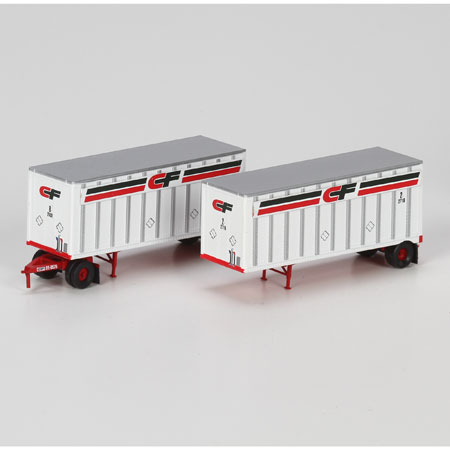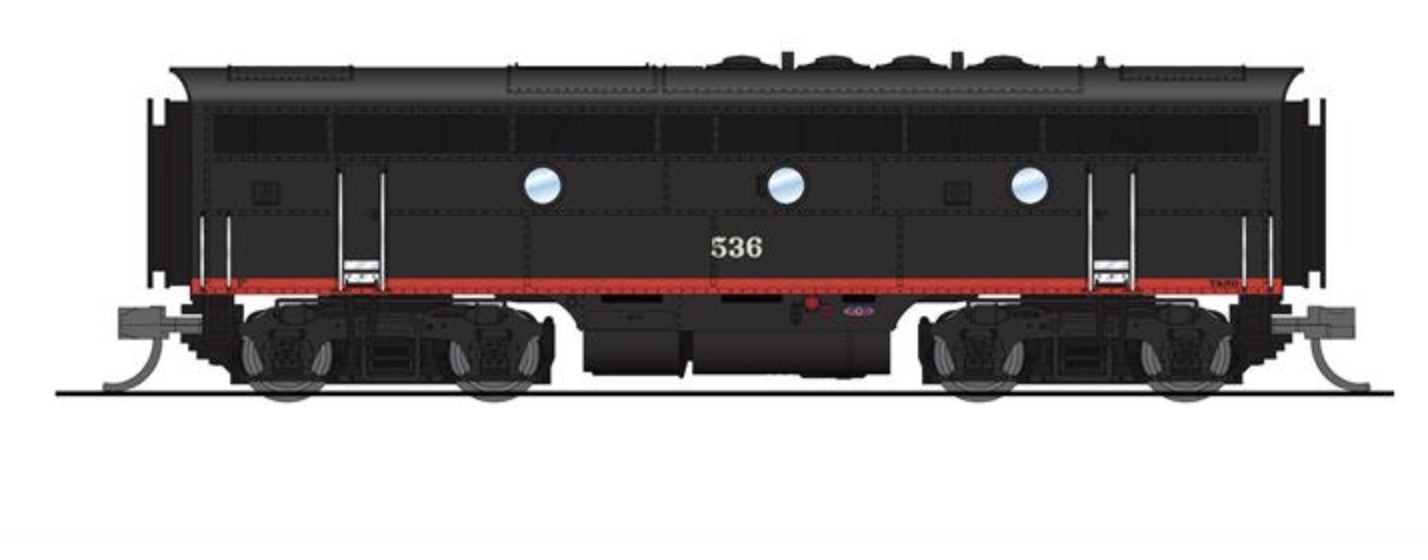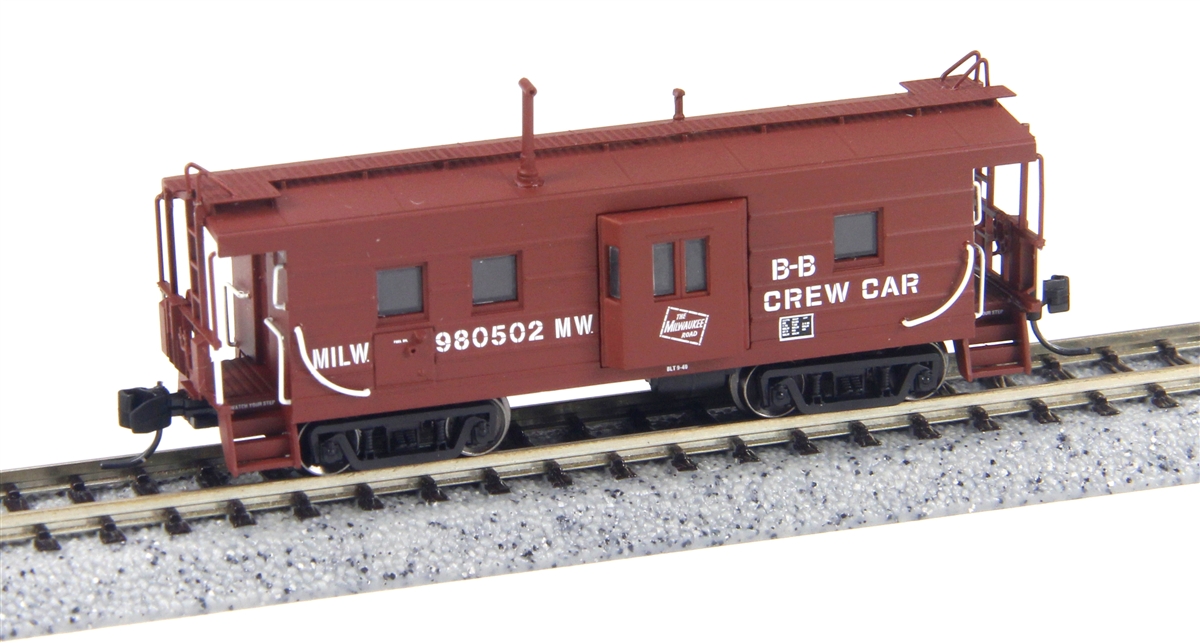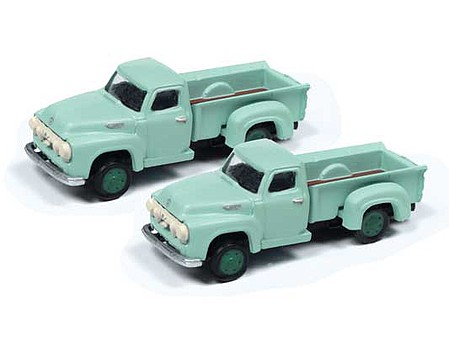Specific Item Information: N RTR 28 foot Trailers w/Dolly, CF #2 (2)
Model Information: Model: Introduction: 2006. ERA: 1960s to 1990s.
Features: Beaded side body, Razor-sharp printing and painting, Perfect for TOFC operation, Interchangable landing gear (raised or lowered), Working rear sliding bogie, Upgraded tooling from A-Line
Features: Beaded side body, Razor-sharp printing and painting, Perfect for TOFC operation, Interchangable landing gear (raised or lowered), Working rear sliding bogie, Upgraded tooling from A-Line
Prototype History: The 28' trailer provided LTL service for instances where a full size trailer would not be the most efficient. Splitting a haul into two creates more efficiency as one trailer can be spotted and then the second taken to a different destination without repacking. Many of the 28' trailers can be seen in TOFC service to this day.
Box vans are known as such for their rectilinear proportions. Their simple design makes them easy to manufacture and maintain.
Box vans are known as such for their rectilinear proportions. Their simple design makes them easy to manufacture and maintain.
Road Name History:  In 1939, CF Inc. started its own truck manufacturing operation, Freightliner, which for decades it operated jointly with White Motor Company. On July 31, 1981, it sold its truck manufacturing business and the Freightliner brand to Daimler AG. In 1981, CF won in a case before the U.S. Supreme Court, Kassel v. Consolidated Freightways Corp.. The court found that Iowa's length restriction on tractor-trailers violated the Dormant Commerce Clause.
In 1939, CF Inc. started its own truck manufacturing operation, Freightliner, which for decades it operated jointly with White Motor Company. On July 31, 1981, it sold its truck manufacturing business and the Freightliner brand to Daimler AG. In 1981, CF won in a case before the U.S. Supreme Court, Kassel v. Consolidated Freightways Corp.. The court found that Iowa's length restriction on tractor-trailers violated the Dormant Commerce Clause.
In 1983, CF Inc. ventured into regional trucking with its spin off Con-Way carriers. Whereas Consolidated Freightways' drivers and dockworkers were unionized, the new Conways (Con-way Central Express (CCX), Con-way Western Express (CWX), Con-way Eastern Express (CEX), etc.) were nonunion, creating tense relations with CF's Teamsters.
On April 3, 1989, CF Inc. purchased Emery Air Freight Corp. merging it with their own CF AirFreight operation and renamed it Emery Worldwide. This, along with Menlo Forwarding, was later sold to UPS.
In 1996, Consolidated Freightways, Inc. spun off its unionized long-haul trucking company, CF MotorFreight, creating two separate publicly traded companies. Parent company, Consolidated Freightways, Inc. was renamed CNF Transportation Inc., reflecting the familiar stock ticker symbol of the company (CNF). CNF retained the Con-Way regional truck companies, Emery Worldwide and a growing logistical systems department.
Consolidated Freightways Corporation filed for Chapter 11 bankruptcy on September 3, 2002, and ceased operations. April 18, 2006, CNF Transportation re-branded itself under its Con-Way image and continues in business today. On October 30, 2015, Con-way Trucking was acquired by Greenwich, CT-based XPO Logistics, Inc.
From Wikipedia

In 1983, CF Inc. ventured into regional trucking with its spin off Con-Way carriers. Whereas Consolidated Freightways' drivers and dockworkers were unionized, the new Conways (Con-way Central Express (CCX), Con-way Western Express (CWX), Con-way Eastern Express (CEX), etc.) were nonunion, creating tense relations with CF's Teamsters.
On April 3, 1989, CF Inc. purchased Emery Air Freight Corp. merging it with their own CF AirFreight operation and renamed it Emery Worldwide. This, along with Menlo Forwarding, was later sold to UPS.
In 1996, Consolidated Freightways, Inc. spun off its unionized long-haul trucking company, CF MotorFreight, creating two separate publicly traded companies. Parent company, Consolidated Freightways, Inc. was renamed CNF Transportation Inc., reflecting the familiar stock ticker symbol of the company (CNF). CNF retained the Con-Way regional truck companies, Emery Worldwide and a growing logistical systems department.
Consolidated Freightways Corporation filed for Chapter 11 bankruptcy on September 3, 2002, and ceased operations. April 18, 2006, CNF Transportation re-branded itself under its Con-Way image and continues in business today. On October 30, 2015, Con-way Trucking was acquired by Greenwich, CT-based XPO Logistics, Inc.
From Wikipedia
Brand/Importer Information: Athearn's history began in 1938, when its founder-to-be, Irvin Athearn, started an elaborate O scale layout in his mother's house. After placing an ad selling the layout, and receiving much response to it, Irv decided that selling model railroads would be a good living. He sold train products out of his mother's house through most of the 1940s. After becoming a full-time retailer in 1946, Irv opened a separate facility in Hawthorne, California in 1948, and that same year he branched into HO scale models for the first time.
Athearn acquired the Globe Models product line and improved upon it, introducing a comprehensive array of locomotive, passenger and freight car models. Improvements included all-wheel drive and electrical contact. One innovation was the "Hi-Fi" drive mechanism, employing small rubber bands to transfer motion from the motor spindle to the axles. Another was the double-ended ring magnet motor, which permitted easy connection to all-wheel-drive assemblies. Athearn was also able to incorporate flywheels into double-ended drives.
The company produced a model of the Boston & Maine P4 class Pacific steam locomotive which incorporated a cast zinc alloy base and thermoplastic resin superstructure. It had a worm drive and all power pickup was through the bipolar trucks that carried the tender. This item was discontinued after the Wilson motor was no longer available, and was not redesigned for a more technologically advanced motor.
Athearn's car fleet included shorter-than-scale interpretations of passenger cars of Southern Pacific and Atchison, Topeka & Santa Fe Railroad prototypes. The company also offered a variety of scale-length freight cars with sprung and equalized trucks. The cars could be obtained in simple kit form, or ready-to-run in windowed display boxes. The comprehensive scope of the product line contributed to the popularity of HO as a model railroad scale, due to the ready availability of items and their low cost.
Irv Athearn died in 1991. New owners took control in 1994, but continued to follow Athearn's commitment to high-quality products at reasonable prices. Athearn was bought in 2004 by Horizon Hobby. Athearn was then moved from its facility in Compton to a new facility in Carson, California. In mid-2009, all remaining US production was moved to China and warehousing moved to parent Horizon Hobby. Sales and product development was relocated to a smaller facility in Long Beach, California.
Read more on Wikipedia and Athearn website.
Athearn acquired the Globe Models product line and improved upon it, introducing a comprehensive array of locomotive, passenger and freight car models. Improvements included all-wheel drive and electrical contact. One innovation was the "Hi-Fi" drive mechanism, employing small rubber bands to transfer motion from the motor spindle to the axles. Another was the double-ended ring magnet motor, which permitted easy connection to all-wheel-drive assemblies. Athearn was also able to incorporate flywheels into double-ended drives.
The company produced a model of the Boston & Maine P4 class Pacific steam locomotive which incorporated a cast zinc alloy base and thermoplastic resin superstructure. It had a worm drive and all power pickup was through the bipolar trucks that carried the tender. This item was discontinued after the Wilson motor was no longer available, and was not redesigned for a more technologically advanced motor.
Athearn's car fleet included shorter-than-scale interpretations of passenger cars of Southern Pacific and Atchison, Topeka & Santa Fe Railroad prototypes. The company also offered a variety of scale-length freight cars with sprung and equalized trucks. The cars could be obtained in simple kit form, or ready-to-run in windowed display boxes. The comprehensive scope of the product line contributed to the popularity of HO as a model railroad scale, due to the ready availability of items and their low cost.
Irv Athearn died in 1991. New owners took control in 1994, but continued to follow Athearn's commitment to high-quality products at reasonable prices. Athearn was bought in 2004 by Horizon Hobby. Athearn was then moved from its facility in Compton to a new facility in Carson, California. In mid-2009, all remaining US production was moved to China and warehousing moved to parent Horizon Hobby. Sales and product development was relocated to a smaller facility in Long Beach, California.
Read more on Wikipedia and Athearn website.
Item created by: George on 2016-09-16 08:46:56. Last edited by denverdave49 on 2022-03-29 00:23:50
If you see errors or missing data in this entry, please feel free to log in and edit it. Anyone with a Gmail account can log in instantly.
If you see errors or missing data in this entry, please feel free to log in and edit it. Anyone with a Gmail account can log in instantly.










